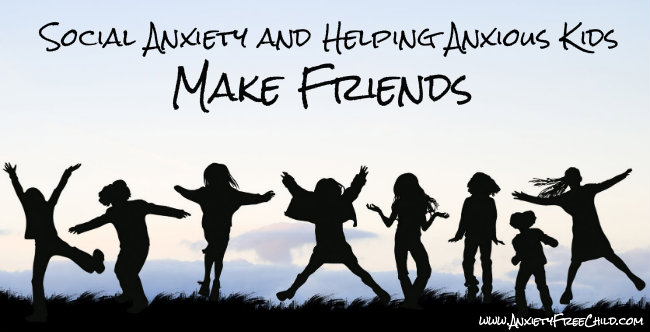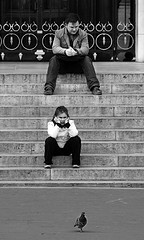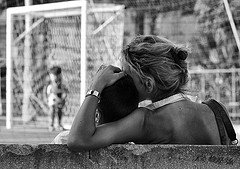 Speaking up in class. Reading out loud. Fitting in. Making new friends.
Speaking up in class. Reading out loud. Fitting in. Making new friends.
For most children, these social activities can feel a bit nerve-wracking at times. But for kids with social anxiety disorder, these normal parts of growing up can be stressful, terrifying – and even debilitating. And for parents, watching a child suffer from social anxiety can be absolutely heartbreaking and is frequently what first brings them to our child anxiety program seeking help.
Social anxiety disorder is more common than you may think. About 15 million Americans suffer from the disorder, according to the National Institutes of Mental Health, making it the third most common mental health disorder in the country.
Also known as SAD or social phobia, social anxiety disorder often begins in childhood or early adolescence. While the median age of onset is 13, it can be detected in children as young as 8 years of age, according to Dr. Joseph Gonzalez-Heydritch of Children’s Hospital Boston.
Often, children with SAD are simply dismissed as being extremely shy. However, shyness and social anxiety are very different; while shy children may feel uncomfortable around others, they don’t react to social situations – or anticipate social situations – with the extreme dread and anxiety that kids with SAD experience. In fact, according to Boston University, many children and youth with SAD aren’t shy at all around certain people or in certain situations. This seemingly confusing trait may lead many parents to ask: What exactly is social anxiety and how can I help my child overcome it?
What is Social Anxiety Disorder?
The Diagnostic and Statistical Manual of the American Psychiatric Association (DSM) defines social anxiety disorder as a persistent fear of social or performance situations in which an individual feels they’re being subjected to scrutiny by others, or may be exposed to unfamiliar people. Kids suffering from SAD worry that they’ll do something to embarrass themselves, or that their anxious feelings will show.
They also tend to feel like others are watching them– and judging everything they do harshly – and overestimate the chances that others will reject them. These fears lead to excessive self-consciousness and overwhelming anxiety in even the most innocuous-seeming social situations. Children with SAD may even have panic attacks – leading them to avoid potentially stressful situations as much as possible.
Social anxiety may be limited to just a few, specific situations, such as eating or drinking in front of others or answering questions in class. For others, SAD may be “generalized,” or include fears so broad that children have a difficult time spending time around anyone who’s not in their families.
Social phobia affects between .5 and 4% of children in the U.S.; among adolescents, that number jumps up to 7%, says Gonzalez-Heydritch. SAD rates are equal amongst males and females, as well as individuals from different cultures and ethnic groups, according to the University of Central Florida’s Anxiety Disorders Clinic.
No one is sure exactly what causes SAD. However, many researchers believe that a combination of biological and psychological factors influence the disorder. Characteristics that can lead to an increased risk of SAD may include:
- Suffering a traumatic social experience
- Growing up around family members that display socially phobic behaviors
- Having a parent with SAD
- Having biological family with a history of anxiety disorders
Ironically, most people with SAD recognize that their fears are actually excessive and unreasonable. They just aren’t able to overcome them – without some help.
Impacts of Social Anxiety
 The avoidance, anxiety and even the anticipation of potentially feeling anxious interferes with daily life, whether academic performance or social relationships. For instance, studies show that 75% of teens with SAD report having few – or even no — friends, 50% don’t participate in any extracurricular activities, and 10% won’t attend school regularly, according to Gonzalez-Heydritch.
The avoidance, anxiety and even the anticipation of potentially feeling anxious interferes with daily life, whether academic performance or social relationships. For instance, studies show that 75% of teens with SAD report having few – or even no — friends, 50% don’t participate in any extracurricular activities, and 10% won’t attend school regularly, according to Gonzalez-Heydritch.
In fact, a wide body of research reflects the significant impacts of social anxiety disorder. A meta-study of the literature on SAD among children and youth by Dr. Todd Kashdan of George Madison University and Dr. James Herbert of Drexel University found that, when compared to non-socially anxious youth, children with SAD tend to:
- Have higher levels of negative affect
- Perceive that they have less social support
- Have fewer close relationships
- Have a higher risk of alcohol and substance abuse
- Display higher levels of social pessimism
- Have personality traits such as hypersensitivity to criticism, difficulty being assertive, and feelings of inferiority
- Be less likely to get married
- Have a greater tendency to live with biological family members
- Be more likely to have suicidal thoughts
- Be more likely to develop other anxiety disorders
The inherent nature of social anxiety disorder means that children who suffer from it want to be “invisible,” avoiding any behavior that might draw attention to themselves. As a result, they tend to be quiet, withdrawn and overlooked in the classroom – so parents, teachers and other school personnel children may not realize how profound the issue really is.
Making SAD even more frustrating, many children aren’t able to effectively verbalize what they’re feeling, leading many parents to classify their kids as simply “going through a shy phase” instead of suffering from a – treatable — anxiety disorder.
So how do parents know if their child has SAD?
How Parents Can Recognize Social Anxiety Symptoms
Social anxiety symptoms differ by age group. However, certain emotional, behavioral, and physiological symptoms may appear across age lines.
 Emotional and Behavioral Symptoms:
Emotional and Behavioral Symptoms:
- Persistent, intense fear of situations where the child is subjected to possible scrutiny or judgment from others
- Fear of situations where the child will be exposed to unfamiliar people
- Feelings of overwhelming anxiety in certain social situations
- Fear of social activities
- Avoidance of social situations
- Excessive fear of being thought foolish by others
- Dread of social events that begins days or weeks in advance
- A strong need to stay quiet, hidden, or be invisible
- An understanding that the fear is unreasonable or excessive
Physical Symptoms:
- Blushing or red face
- Racing heart
- Sweating or hot flashes
- Trembling or shaking
- Nausea
- Dizziness or feeling faint
- Difficulty speaking
- Shaky voice
Children
Among children, additional symptoms of social anxiety may include:
- Crying
- Incorrect beliefs that strangers are talking about or looking at them
- Blaming others for perceived social failures
- Tantrums
- Excessive clinging to familiar people
- Freezing
- Elective mutism or refusal to speak in public
- Timidity in unfamiliar settings or in front of unfamiliar people
Adolescents
Among older children and adolescents, social anxiety disorder may manifest through symptoms such as:
- Irritability
- Rigid or inflexible personalities
- Excessive concern with being looked at
- Self-deprecation
- Fighting
- Truancy
- Anti-social behavior
- Refusing to attend school or participate in extra-curricular activities
- Extreme test anxiety
- Low self-confidence and feelings of inferiority
- Hypersensitivity to judgment or criticism
- Drinking alcohol before social events to calm anxiety
For youth under 18 years old, the DSM notes that symptoms must last for at least 6 consecutive months for a diagnosis of social anxiety disorder.
If you suspect your child may have social anxiety, Gonzalez-Heydritch recommends asking yourself a series of questions, including:
- Does your child seem excessively shy?
- Does your child avoid talking to people s/he doesn’t know very well?
- Does your child blush often?
- Does your child avoid attention?
- Does your child fear criticism?
- If your child afraid of doing things when others are watching?
- Does your child avoid speaking to authority figures?
- Does your child experience trembling or shaking when others are around?
- Does your child cling to you in social settings?
- Does your child avoid talking to classmates on the phone?
- Does your child avoid joining clubs or attending parties?
Four Ways Parents Can Help
If you think your child is suffering from SAD, you can take these four steps to help reduce their anxiety and help them make friends.
Teach Calming Strategies
 Anxious feelings trigger physiological changes in the body. Among the first signs of anxiety? Rapid breathing.
Anxious feelings trigger physiological changes in the body. Among the first signs of anxiety? Rapid breathing.
When we breathe quickly, the balance of oxygen and carbon dioxide gets off-kilter, resulting in other physiological changes such as an increased heart rate, muscle tension and dizziness – all of which mimic the sensations anxiety produces.
Fortunately, his vicious cycle is easily broken; teach your child to follow the following breathing technique when they’re feeling panicked in public.
- Have your child sit in a comfortable position with their back straight. They should place one hand on their belly and one hand on their chest.
- Ask your child to slowly inhale through their nose for four seconds; they should feel the hand on their belly rise, while the hand on their chest stays almost still.
- Have your child hold the breath for two seconds, then exhale slowly through the mouth for six seconds. Now the hand on their belly should move in, while the hand on their chest remains almost still.
- Continue to inhale for four seconds, hold the breath for two seconds, and exhale for six seconds. Ask your child to focus on the movement of their breath, creating a steady, calm pattern.
Conquer Negative Thoughts
 Children who experience SAD are often overwhelmed by negative thoughts and beliefs that both reinforce and underlie their anxiety. Teaching your child to challenge these negative thoughts by replacing them with positive, yet realistic, thoughts can help reduce anxiety.
Children who experience SAD are often overwhelmed by negative thoughts and beliefs that both reinforce and underlie their anxiety. Teaching your child to challenge these negative thoughts by replacing them with positive, yet realistic, thoughts can help reduce anxiety.
For kids with social phobia, negative thoughts generally fall into one of these categories:
- Believing that everyone else sees them through a negative, critical lens: “They all see how stupid I am.”
- Always assuming that bad things going to happen: “There’s no way I won’t fail.”
- Overreacting or blowing things out of proportion: “If my voice shakes during my presentation, my life will be ruined forever.”
- Personalizing or assuming that other people are fixated on them in a negative way: “She’s in a bad mood today – what did I do to offend her?”
Help your child to recognize these thought patterns and to identify negative thoughts for what they are: Unrealistic and incorrect. Teach your child to challenge these negative thoughts by asking questions about them: “Will anyone really care if my voice shakes a bit while I’m talking?” “Maybe she’s just having a bad day and it’s nothing to do with me.”
Now, encourage your child to replace those negative thoughts with positive – yet still realistic – thoughts. “Yes, my voice might shake, but everyone else is probably too nervous about their own speech to notice.” “I’ve prepared for this exam, I’ll probably do just fine.”
With time and practice, the process of identifying, challenging, and replacing negative thoughts will become a habit – and reduce some of your child’s social anxiety triggers.
Teach Problem Solving
 Often, children with social anxiety practice avoidance techniques to stay away from the situations that cause them stress and fear. For parents, it often seems simpler to just take over and do the things that your child wants to avoid, such as ordering for them in restaurants or making phone calls for them.
Often, children with social anxiety practice avoidance techniques to stay away from the situations that cause them stress and fear. For parents, it often seems simpler to just take over and do the things that your child wants to avoid, such as ordering for them in restaurants or making phone calls for them.
However, engaging in avoidance behaviors won’t help your child to conquer their anxiety. Instead, encourage your child to take control of their social anxiety by teaching a problem solving approach.
- When your child expresses a fear or anxiety, summarize what they’ve said; “You’re feeling worried about reading out loud in class tomorrow.”
- Have your child brainstorm different steps they could take to reduce the anxiety; Read through the passage several times, practice reading out loud in front of the family, practice reading the passage with a trusted peer.
- Don’t come up with all the answers or tell your child what they should do.
- For each possibility that your child comes up with, ask several questions: “What would happen if you did it that way? What would be the worst possible result? What’s the likelihood that the worst possible result would happen? Would this make you feel better?”
- Encourage your child as they discuss possible outcomes, and offer praise for coming up with solutions.
- Help your child choose the solution that allows them to achieve a positive outcome without avoiding the feared situation.
Facilitate Friendships
 Though you can’t make friends for your child, you can help provide them with the skills to do it themselves. One of the best ways is by letting your child practice their social skills through role-playing.
Though you can’t make friends for your child, you can help provide them with the skills to do it themselves. One of the best ways is by letting your child practice their social skills through role-playing.
- Choose a realistic scenario; for younger kids, this may be asking someone to play at recess. For older kids, this may involve asking someone over for a study date.
- Have your child pretend to be the other person. Then model the behavior the child should have, such as smiling and saying hello in a confident voice.
- Once you’ve gone through the scenario a few times, switch roles. Have your child pretend they’re asking you to play or to come over and study.
- Praise their efforts! Be specific about the things they did right.
- If they need to improve, lightly suggest they focus on that area next time.
- Go through the role-play again until your child feels confident in their skills. You can even videotape the practice so your child can see the improvement they are making.
The good news is that parents can do a lot to help their child overcome social anxiety disorder. By teaching calming techniques and problem solving skills and using positive reinforcement to encourage progress – even small steps forward – you can help your child conquer negative thought patterns that trigger anxiety. With practice and patience, you can help your child learn to think about their fears more realistically and confront stressful situations.
SOURCES:
http://www.socialanxietyinstitute.org/dsm-definition-social-anxiety-disorder
http://psychfaculty.gmu.edu/kashdan/publications/childsad.pdf
http://web1.tch.harvard.edu/views/october08/social_anxiety_disorder.html
http://web.monroecc.edu/manila/webfiles/cfinch/socialanxiety1.pdf
http://www.bu.edu/card/get-help/child-programs/child-conditions/social-anxiety-child/
http://www.med.upenn.edu/ctsa/social_anxiety_symptoms.html
http://www.nimh.nih.gov/statistics/1ANYANX_child.shtml
http://www.nimh.nih.gov/health/publications/anxiety-disorders/social-phobia-social-anxiety-disorder.shtml
http://www.adaa.org/living-with-anxiety/children
http://www.adaa.org/understanding-anxiety/social-anxiety-disorder
http://www.nimh.nih.gov/science-news/2007/behavioral-therapy-effectively-treats-children-with-social-phobia.shtml
http://www.helpguide.org/mental/social_anxiety_support_symptom_causes_treatment.htm
http://www.aboutourkids.org/articles/keys_helping_socially_anxious_teenagers_school_personnel_parents
Photo Credit: adwriter, World Bank Photo Collection, julien, bubbo.etsy.com, NaturaLite’s “snap decisions”





